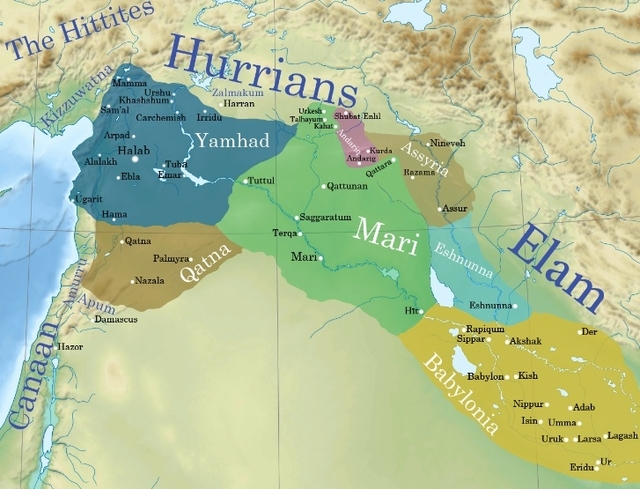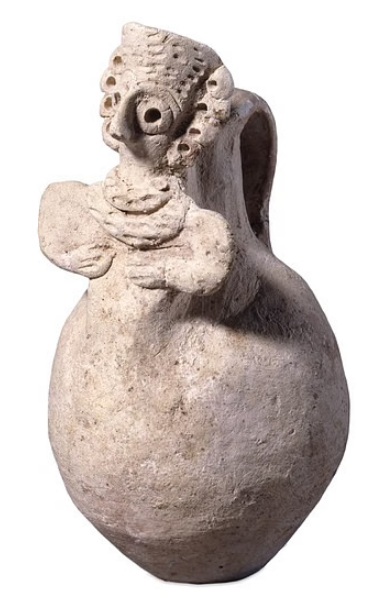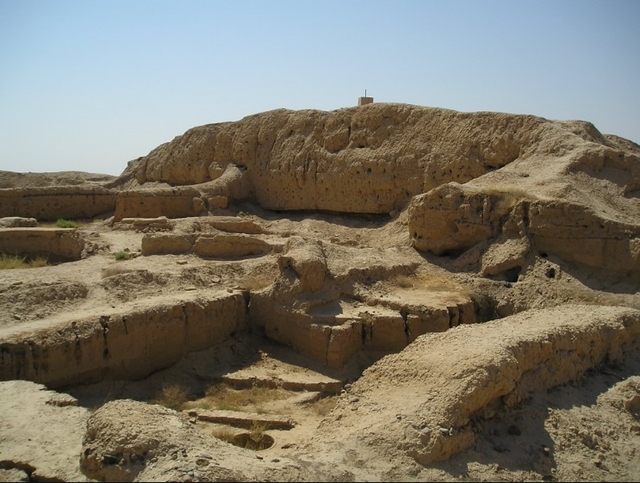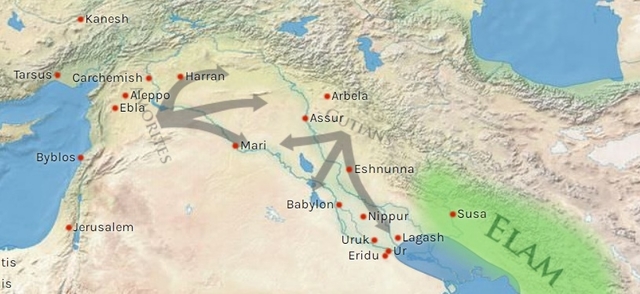
| AMORITES / MARUTS The Amorites were Aryan people who seem to have emerged from western Mesopotamia (modern-day Syria) at some point prior to the 3rd millennium BCE. In Sumerian they were known as the Martu or the Tidnum (in the Ur III Period), in Akkadian by the name of Amurru, Egypt as Amar, and in Vedic Aryans as Maruts all of which mean 'westerners' or 'those of the west', as does the Hebrew name Amorite.
They worshipped their own pantheon of gods with a chief deity named Amurru (also known as Belu Sadi - 'Lord of the Mountains' whose wife, Belit-Seri was 'Lady of the Desert'), which also became a designation for the people as the Akkadians also referred to them as 'the people of Amurru' and to the region of Syria as 'Amurru'. There is no record of what the Amorites called themselves.
The god Amurru's association with the mountains and his wife's with the desert suggests that they may have originated in the area of Syria around Mount Hermon, but this is unsubstantiated. From their first appearance in the historical record, the Amorites had a profound impact on the history of Mesopotamia and are probably best known for their kingdom of Babylonia under the Amorite king Hammurabi (r. 1792-1750 BCE). The span between 2000-1600 BCE in Mesopotamia is known as the Amorite Period, during which their impact on the region can most clearly be discerned, but there is no doubt that they influenced the people of the various cities long before that time, and their impact was felt long after.
Amorites grew more powerful as they acquired more land until finally they directly threatened the stability of those in the established cities of the region.
This situation came to crisis during the latter part of the Ur III Period (also known as the Sumerian Renaissance, 2047-1750 BCE), when King Shulgi of the Sumerian city of Ur constructed a wall 155 miles (250 kilometers) long specifically to keep the Amorites out of Sumer. The wall was too long to be properly manned, however, and also presented the problem of not being anchored at either end to any kind of obstacle; an invading force could simply walk around the wall to bypass it, and that seems to be precisely what the Amorites did.
Amorite incursions led to the weakening of Ur and Sumer as a whole, which encouraged the region of Elam to mount an invasion and break through the wall. The sack of Ur by the Elamites in 1750 BCE ended Sumerian civilization, but this was made possible by the earlier incursions of the Amorites and their migrations throughout the region which undermined the stability and trade of the cities.
Ancient Syro-Mesopotamia ca. 1764 BCE This map shows the political situation in Syro-Mesopotamia c. 1764 BCE. During this time, the Amorite Kings, Hammurabi of Babylon and Zimri-Lim of Mari were engaged in near-constant warfare with surrounding polities, many of whom were also predominantly Amorite. The two kings crushed powers like Eshnunna and fought back the Elamites. In 1761 BCE, Babylon is known to have taken control of Mari and its territories, and the reasons behind this are unclear to this day.
Amorite, about 2400-2000 BC :
Amorite, about 2400 - 2000 BC From the Middle Euphrates region, Syria This juglet, with its applied figurine, is pierced at the base and may have been a strainer. Alternatively it could have been used a sprinkler, by clamping a thumb over the top when the vessel was filled with liquid, then withdrawing it gently and so releasing the pressure.
Much of the Middle Euphrates region now lies beneath the waters of a lake. Between 1963 and 1973 an international rescue mission excavated many sites in the area, which was threatened by flooding as a result of the construction of the Tabqa dam. These excavations revealed a distinctive regional culture.
During the period from about 2400 to 2000 BC, northern Mesopotamia and Syria appear to have been dominated by a number of expanding sites. Mari on the Euphrates and Ebla (modern Tell Mardikh, south-west of Aleppo) were among the most important. Over 8000 inscribed clay tablets discovered at Ebla show close contact with Mari and indicate that the site wielded extensive political power. Contacts with cities in the south of Mesopotamia were also significant. At the end of the third millennium BC King Sargon, or Naram-Sin, who was ruler of Agade, one of these southern cities, campaigned into the north and destroyed Ebla, thus changing the balance of power
The
Amorite Period in Mesopotamia :
The Amorites of Babylon seem to have been regarded positively in the region, while the roaming Amorites continued to be a source of instability. The Amorites of Babylon, just as those who inhabited other cities, worshipped Sumerian gods and wrote down Sumerian myths and legends. Hammurabi expanded the old city of Babylon and engaged in a number of successful military campaigns (one being the destruction of rival city Mari in 1761 BCE) that brought the vast region of Mesopotamia from Mari to Ur under Babylon's rule and established the city as the center of Babylonia (an area of land corresponding to modern-day Syria to the Persian Gulf). Hammurabi's military, diplomatic, and, political skills served to make Babylon the largest city in the world at the time and the most powerful. He was unable, however, to pass these talents on to his son and, after his death, the kingdom he had built began to fall apart.
Remains of the ziggurat attached to the so-called Temple of Lions at Mari These are the excavated remains of a 40-foot terrace which was attached to a temple at Mari referred to as the "Temple of Lions" by excavators. The temple, also known as the "Temple of the King of the Land" was built by the ruler, Ishtup-Ilum, in the 22nd century BCE and dedicated to the god, Degan. The temple and terrace were excavated at the site, modern-day Tell Hariri, Syria, in the 20th century CE.
Hammurabi's son, Samsu-Iluna (r. 1749-1712 BCE) could not continue the policies his father had enacted nor defend the empire against invading forces such as the Hittites and Assyrians. The Assyrians were the first to make incursions and allowed for regions south of Babylon to break away from the empire easily. Hammurabi's conquest of Eshnunna in the north-east had removed a buffer zone and placed the border in direct contact with tribes such as the Kassites. The greatest blow came in 1595 BCE when Mursilli I of the Hittites (1620-1590 BCE) sacked Babylon and carried away the treasures of the city's temples and scattered the population, as he had done five years earlier, in 1600 BCE, at Ebla.
The Kassites followed the Hittites in taking Babylon and renaming it, and they, in turn, were followed by the Assyrians. The Amorite Period in Mesopotamia was ended by 1600 BCE, though it is clear through the distinctive Semitic names of individuals on record that Amorites continued to live in the area as part of the general population. Amorites continued to pose problems for the Neo-Assyrian Empire as late as c. 900-800 BCE. In time, the cultural Amorites came to be referred to as 'Aramaeans' and the land they came from as Aram, possibly from the old designation of Eber Nari. Following the decline of the Neo-Assyrian Empire in c. 600 BCE, Amorites no longer appear under the name 'Amorite' in the historical record.
Gutian and Amorite Invasions - 2100 BCE Note :
Mention of Amorites (Maruts) can be found in Aryan scriptures such as Veds which western scholars have not referred to hence keeping in mind the Vedic Aryan point of View I (Dr. Gaurav A. Vyas) have edited the original source.
Source :
https://www.worldhistory.org/amorite/ |



